
- Home
- Travel Packages
- Top Destination
-
Travel Attraction
By Category
Top Attraction

- Travel Agents
- Car Rentals
- Hotels
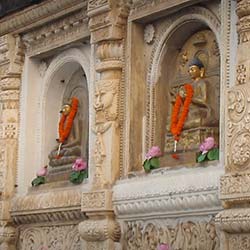
About Mahabodhi Temple, Bodhgaya Bodhgaya, located in the state of Bihar, India, is famous as the place where Prince Siddhartha Gautama attained enlightenment and became the Buddha. The Mahabodhi Temple in Bodhgaya is a UNESCO World Heritage Site and is considered one of the holiest Buddhist pilgrimage sites in the world. History, Architecture, and Design The Mahabodhi Temple was originally built by Emperor Ashoka in the 3rd century BC to commemorate the Buddha's enlightenment. The current temple, however, dates back to the 5th-6th century AD and is a fine example of Indian brickwork and sculptural art. The architecture reflects a blend of Indian, Chinese, and Burmese styles, with a central tower rising to a height of 55 meters. Best Time to Visit The best time to visit the Mahabodhi Temple is during the winter months from October to March when the weather is pleasant and conducive for exploring the complex. Avoid visiting during the summer months as the temperatures can soar and make sightseeing uncomfortable. Cultural Significance The Mahabodhi Temple holds immense cultural significance as the place where the Buddha achieved enlightenment. It is a sacred site for Buddhists around the world and attracts pilgrims and tourists alike. The temple complex also houses a sacred Bodhi tree, which is believed to be a direct descendant of the tree under which the Buddha meditated. Pilgrimage Practices Pilgrims visiting the Mahabodhi Temple often perform rituals such as circumambulating the temple, offering prayers, and meditating under the Bodhi tree. It is a place for reflection, meditation, and seeking spiritual enlightenment. Pilgrims also offer flowers, incense, and candles as offerings to the Buddha. Dress Code and Etiquette Visitors are required to dress modestly and respectfully when visiting the Mahabodhi Temple. Avoid wearing revealing clothing or shorts, and remember to remove your shoes before entering the temple complex. Silence and respect for the sacredness of the site are also important. Activities and Experiences Visitors to the Mahabodhi Temple can participate in meditation sessions, attend Buddhist teachings, and explore the temple complex and its surrounding gardens. The temple also hosts various cultural events and ceremonies throughout the year, providing visitors with a rich and immersive experience. Art and Religious Symbols The Mahabodhi Temple is adorned with intricate carvings, sculptures, and reliefs depicting scenes from the life of the Buddha and various Buddhist deities. The temple's architecture and design are rich in symbolism and serve as a visual representation of Buddhist beliefs and teachings. Local Insights Locals in Bodhgaya are deeply connected to the Mahabodhi Temple and often participate in the daily rituals and ceremonies held at the site. Visiting during festivals such as Buddha Purnima or the Dalai Lama's teachings can provide a unique insight into the local culture and traditions. Interacting with locals and attending local events can enhance your overall experience of Bodhgaya.
Explore More
About the Bodhi Tree, Bodhgaya History The Bodhi Tree in Bodhgaya is believed to be the exact spot where Siddhartha Gautama, the Buddha, attained enlightenment over 2,500 years ago. The tree is a descendant of the original tree under which the Buddha meditated. It has since become a sacred site for Buddhists from around the world. Architecture and Design The Bodhi Tree is a majestic fig tree that stands within the Mahabodhi Temple complex. The temple itself is a magnificent example of ancient Indian architecture, with intricate carvings and sculptures depicting the life of the Buddha. The tree is surrounded by a low fence to protect its roots, and devotees can meditate under its branches. Best Time to Visit Cultural Significance The Bodhi Tree is considered one of the most important Buddhist pilgrimage sites in the world. It symbolizes the Buddha's enlightenment and serves as a focal point for meditation and prayer. Pilgrims from all over the world come to Bodhgaya to pay their respects to the tree and seek spiritual enlightenment. Pilgrimage Practices Visitors to the Bodhi Tree often participate in traditional Buddhist rituals, such as offering incense, flowers, and prayers. Many pilgrims also choose to circumambulate the tree, walking in a clockwise direction as a sign of respect. Some may spend hours meditating under the tree, seeking inner peace and enlightenment. Dress Code and Etiquette When visiting the Bodhi Tree, it is important to dress modestly and respectfully. Both men and women should cover their shoulders and legs, and remove shoes before entering the temple complex. Silence and mindfulness are encouraged, as the site is considered a place of contemplation and spiritual reflection. Activities and Experiences Art and Religious Symbols The Bodhi Tree and the Mahabodhi Temple are adorned with intricate carvings and statues that depict scenes from the life of the Buddha. These artistic representations serve as a visual reminder of the teachings of Buddhism and the importance of enlightenment. The tree itself is a living symbol of growth and transformation. Local Insights Local guides and monks are often available to provide insight into the history and significance of the Bodhi Tree. They can offer spiritual guidance and answer questions about Buddhist practices and beliefs. Visitors can also explore the nearby villages and markets to experience local culture and cuisine, gaining a deeper understanding of the region's traditions and way of life.
Explore More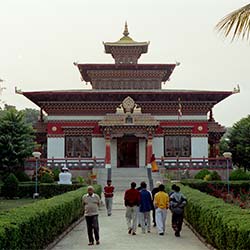
About the Chinese Temple in Bodhgaya History, Architecture, and Design The Chinese Temple in Bodhgaya, also known as the Indosan Nippon Japanese Temple, is a peaceful and beautifully designed structure that serves as a place of worship and meditation for Buddhist practitioners. The temple was built in the 1970s with contributions from various countries, including China, Japan, and India. The architecture of the temple blends traditional Chinese and Japanese design elements, creating a unique and tranquil space for visitors to explore and reflect. Best Time to Visit The best time to visit the Chinese Temple in Bodhgaya is during the winter months, from October to March, when the weather is cool and pleasant. This time of year is ideal for exploring the temple grounds and participating in meditation and prayer sessions without the heat and humidity of the summer months. Cultural Significance The Chinese Temple holds great cultural significance for Buddhists around the world, as it is located in Bodhgaya, the site where Siddhartha Gautama, the Buddha, attained enlightenment. The temple is a place of pilgrimage and spiritual retreat for those seeking to deepen their connection to the teachings of Buddhism and honor the historical importance of Bodhgaya. Pilgrimage Practices Many Buddhists visit the Chinese Temple in Bodhgaya as part of a pilgrimage to important Buddhist sites in India. Pilgrims often participate in meditation, prayer, and ritual practices at the temple, seeking spiritual renewal and enlightenment. Visiting the temple is a way for Buddhists to connect with the teachings of the Buddha and deepen their understanding of the path to enlightenment. Dress Code and Etiquette Visitors to the Chinese Temple in Bodhgaya are expected to dress modestly and respectfully, covering their shoulders and knees. It is customary to remove your shoes before entering the temple and to conduct yourself quietly and respectfully while on the temple grounds. It is important to follow the instructions of temple staff and to avoid taking photographs in areas where it is prohibited. Activities and Experiences Visitors to the Chinese Temple in Bodhgaya can participate in a variety of activities and experiences, including meditation sessions, prayer ceremonies, and cultural performances. The temple grounds offer a peaceful and serene environment for contemplation and reflection, with beautiful gardens and ornate statues that create a sense of tranquility and spiritual connection. Art and Religious Symbols The Chinese Temple is adorned with beautiful artwork and religious symbols that hold deep significance for Buddhist practitioners. Intricate carvings, colorful murals, and statues of Buddhas and Bodhisattvas can be found throughout the temple, creating a visually stunning and spiritually inspiring environment for visitors to explore and appreciate. Local Insights Local residents and monks in Bodhgaya provide valuable insights and perspectives on the Chinese Temple, sharing the history and significance of the temple as well as offering guidance on how to best experience and appreciate the spiritual and cultural aspects of the site. Engaging with locals can enhance your visit to the temple and deepen your understanding of the Buddhist traditions and practices that are observed there.
Explore More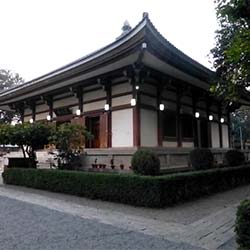
Indosan Nippon Japanese Temple
About Indosan Nippon Japanese Temple, Bodhgaya History The Indosan Nippon Japanese Temple, also known as the Japanese Buddhist Temple, is a tranquil sanctuary located in Bodhgaya, India. The temple was built in 1972 by the Japanese Buddhist monk Nichidatsu Fujii, in collaboration with Indian and Japanese governments. It serves as a symbol of the strong cultural and religious ties between Japan and India. Architecture and Design The Indosan Nippon Japanese Temple features traditional Japanese architectural elements such as a pagoda-style roof, wooden lattice windows, and intricate carvings. The serene garden surrounding the temple adds to its peaceful ambiance and makes it a perfect place for meditation and reflection. Best Time to Visit The best time to visit the Indosan Nippon Japanese Temple is during the winter months from October to March when the weather is pleasant and ideal for exploring the temple grounds. Avoid visiting during the summer months as the temperatures can be scorching hot. Cultural Significance The Japanese Buddhist Temple holds great cultural significance as a place of worship and spiritual practice for followers of Buddhism. It is a sanctuary for pilgrims seeking enlightenment and inner peace, and a symbol of the enduring friendship between Japan and India. Pilgrimage Practices Pilgrims visiting the Indosan Nippon Japanese Temple often engage in meditation, chanting, and offering prayers at the temple. It is a sacred place where devotees can connect with their spiritual beliefs and seek guidance on their path to enlightenment. Dress Code and Etiquette Visitors are required to dress modestly and remove their shoes before entering the temple premises as a sign of respect. It is important to maintain silence and avoid any disruptive behavior while inside the temple to ensure a peaceful environment for meditation and prayer. Activities and Experiences Visitors to the Indosan Nippon Japanese Temple can participate in meditation sessions, attend prayer ceremonies, and explore the beautiful garden surrounding the temple. The serene atmosphere of the temple provides a perfect setting for spiritual contemplation and relaxation. Art and Religious Symbols The temple is adorned with various religious symbols and artwork that represent Buddhist teachings and concepts. Intricate carvings, paintings, and sculptures can be found throughout the temple, creating a visually stunning and spiritually inspiring environment for visitors. Local Insights Local residents and guides can provide valuable insights into the history and significance of the Indosan Nippon Japanese Temple, offering a deeper understanding of its cultural and religious importance. Engaging with the local community can enrich the overall experience of visiting this sacred site.
Explore More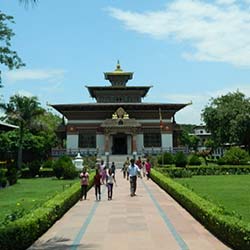
About Royal Bhutan Monastery, Bodhgaya The Royal Bhutan Monastery in Bodhgaya is a beautiful and serene place of worship that holds cultural significance for the Bhutanese people. Its rich history, unique architecture, and peaceful surroundings make it a must-visit destination for those seeking spiritual enlightenment. History The Royal Bhutan Monastery was established in 2003 by the Kingdom of Bhutan as a gift to the Mahabodhi Society of India. It was built to promote peace and harmony among all beings and to honor the teachings of Lord Buddha. The monastery serves as a symbol of the strong bond between Bhutan and India, as well as a beacon of hope for all who seek enlightenment. Architecture and Design The Royal Bhutan Monastery is a stunning example of traditional Bhutanese architecture, with intricate wood carvings, colorful paintings, and ornate decorations. The main temple is adorned with a gold-plated roof and houses a magnificent statue of Buddha. The surrounding gardens and prayer wheels add to the peaceful and meditative atmosphere of the monastery. Best Time to Visit The best time to visit the Royal Bhutan Monastery is during the winter months, from November to February, when the weather is cool and pleasant. This is also the peak tourist season, so you can expect to see the monastery bustling with visitors from all over the world. However, if you prefer a quieter and more peaceful experience, consider visiting during the off-peak months of March to October. Cultural Significance The Royal Bhutan Monastery holds great cultural significance for the Bhutanese people, as it represents their strong ties to Buddhism and their commitment to promoting peace and harmony. The monastery is a place of worship, meditation, and learning, where visitors can immerse themselves in Bhutanese culture and traditions. Pilgrimage Practices Visitors to the Royal Bhutan Monastery are encouraged to participate in traditional pilgrimage practices, such as prostration, circumambulation, and offering prayers and offerings. These practices are believed to purify the mind, body, and soul, and deepen one's connection to the teachings of Buddha. Pilgrims can also receive blessings from the resident monks and take part in special ceremonies and rituals. Dress Code and Etiquette Visitors to the Royal Bhutan Monastery are expected to dress modestly and respectfully, covering their shoulders and knees. Shoes should be removed before entering the temple, and hats and sunglasses should be removed as a sign of respect. Talking loudly, taking photos without permission, and touching or pointing at religious objects are considered disrespectful behaviors and should be avoided. Activities and Experiences Visitors to the Royal Bhutan Monastery can participate in a variety of activities and experiences, such as attending meditation sessions, listening to lectures by resident monks, and taking part in traditional ceremonies and rituals. The monastery also offers guided tours, cultural performances, and workshops on Bhutanese art and handicrafts. Visitors can also explore the surrounding gardens, prayer wheels, and meditation huts for a truly immersive experience. Art and Religious Symbols The Royal Bhutan Monastery is adorned with beautiful art and religious symbols that reflect the rich cultural heritage of Bhutan. Intricate wood carvings, colorful paintings, and ornate decorations depict scenes from the life of Buddha, as well as symbols of peace, wisdom, and compassion. The main temple houses a magnificent statue of Buddha, surrounded by offerings of flowers, candles, and incense. Local Insights Visitors to the Royal Bhutan Monastery can gain valuable insights into Bhutanese culture and traditions by interacting with the resident monks and local devotees. They can learn about the history and significance of the monastery, as well as the daily routines and practices of the monks. Visitors can also explore the nearby villages and markets to experience the local way of life and taste traditional Bhutanese cuisine.
Explore More
About Thai Monastery, Bodhgaya The Thai Monastery in Bodhgaya is a beautiful and serene place of worship for Buddhists from around the world. It holds great historical and cultural significance and is a popular destination for pilgrims seeking spiritual enlightenment. History The Thai Monastery was established in Bodhgaya to commemorate the visit of the King of Thailand in 1956. It was built as a symbol of the strong bond between Thai and Indian Buddhists and serves as a place of meditation and worship for all who visit. Architecture and Design The Thai Monastery features traditional Thai architecture with intricate carvings and colorful decorations. The main hall houses a beautiful statue of the Buddha, surrounded by stunning murals depicting scenes from his life. Best Time to Visit The best time to visit the Thai Monastery in Bodhgaya is during the winter months from November to February when the weather is cooler and more pleasant. This is also the peak season for tourists, so it is advisable to plan your visit in advance. Cultural Significance The Thai Monastery is an important cultural landmark in Bodhgaya, symbolizing the strong ties between Thailand and India. It is a place of spiritual pilgrimage for Buddhists seeking enlightenment and inner peace. Pilgrimage Practices Visitors to the Thai Monastery are encouraged to engage in traditional Buddhist practices such as meditation, chanting, and offering prayers. Pilgrims often circumambulate the main hall three times as a sign of respect and devotion. Dress Code and Etiquette Visitors to the Thai Monastery are required to dress modestly and respectfully. It is recommended to wear clothing that covers the shoulders and knees out of respect for the sacredness of the place. Shoes should also be removed before entering the main hall. Activities and Experiences Visitors to the Thai Monastery can participate in a variety of activities and experiences, including meditation sessions, chanting ceremonies, and teachings by Buddhist monks. The peaceful atmosphere of the monastery provides a perfect setting for self-reflection and spiritual growth. Art and Religious Symbols The Thai Monastery is adorned with beautiful art and religious symbols that hold deep significance in Buddhist culture. Visitors can admire the intricate carvings, paintings, and statues that depict the life and teachings of the Buddha. Local Insights Local residents and monks at the Thai Monastery offer valuable insights into Buddhist practices and traditions. Visitors can engage in meaningful conversations with the locals to gain a deeper understanding of the spiritual significance of the monastery and its teachings.
Explore More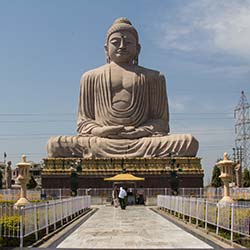
About the Great Buddha Statue, Bodhgaya The Great Buddha Statue in Bodhgaya is a majestic figure that stands tall as a symbol of peace and enlightenment. With a rich history and intricate architecture, this iconic statue attracts visitors from all around the world. History, Architecture, and Design The Great Buddha Statue in Bodhgaya was unveiled in 1989, commemorating the 2,500th anniversary of the Buddha's enlightenment. Standing at a height of 80 feet, the statue is made of sandstone blocks and red granite. The design features intricate carvings and details that represent the Buddha's teachings and journey to enlightenment. Best Time to Visit The best time to visit the Great Buddha Statue in Bodhgaya is during the winter months, from October to March, when the weather is pleasant and suitable for exploring the site. Avoid visiting during the monsoon season, as heavy rains can disrupt your experience. Cultural Significance The Great Buddha Statue holds immense cultural significance as it marks the exact spot where Lord Buddha attained enlightenment. It serves as a reminder of the teachings of peace, compassion, and mindfulness that the Buddha preached, making it a sacred site for Buddhists and spiritual seekers. Pilgrimage Practices Pilgrims from all around the world visit the Great Buddha Statue in Bodhgaya to pay their respects and meditate in the presence of the enlightened one. It is common for visitors to offer prayers, light candles, and perform rituals as a way to connect with the spiritual energy of the site. Dress Code and Etiquette Visitors are expected to dress modestly and respectfully when visiting the Great Buddha Statue in Bodhgaya. It is recommended to wear clothing that covers the shoulders, chest, and knees as a sign of reverence and respect for the sacredness of the site. Activities and Experiences While visiting the Great Buddha Statue, visitors can engage in a variety of activities and experiences such as guided tours, meditation sessions, and cultural performances. The serene surroundings and spiritual ambiance of the site provide a peaceful and introspective experience for all visitors. Art and Religious Symbols The Great Buddha Statue in Bodhgaya is adorned with intricate art and religious symbols that represent the Buddhist faith and teachings. From the lotus flower symbolizing purity to the mudra hand gestures signifying different aspects of the Buddha's journey, every detail of the statue holds deep symbolism and significance. Local Insights Immerse yourself in the local culture and traditions of Bodhgaya by interacting with the friendly locals and exploring the nearby markets and eateries. Gain a deeper understanding of the spiritual significance of the Great Buddha Statue by engaging in conversations with the residents and participating in local customs and rituals.
Explore More
About Tibetan Refugee Market, Bodhgaya History, Architecture and Design The Tibetan Refugee Market in Bodhgaya was established in the 1960s by Tibetan refugees who fled their homeland following the Chinese invasion. The market serves as a hub for the Tibetan community to showcase their traditional crafts and goods. The architecture of the market is inspired by Tibetan design elements, with colorful prayer flags adorning the stalls and intricate wood carvings adding to the charm of the market. Best Time to Visit The best time to visit the Tibetan Refugee Market in Bodhgaya is during the winter months from October to March when the weather is cool and pleasant. This is also the peak tourist season, so you can expect a lively atmosphere at the market during this time. Cultural Significance The Tibetan Refugee Market holds significant cultural importance as it provides a platform for Tibetan refugees to showcase their traditional arts and crafts. It also serves as a reminder of the hardships faced by the Tibetan people and their resilience in preserving their culture and heritage. Pilgrimage Practices Many visitors to Bodhgaya include a visit to the Tibetan Refugee Market as part of their pilgrimage practices. The market offers a unique glimpse into Tibetan culture and traditions, making it a meaningful stop for those on a spiritual journey. Dress Code and Etiquette While there is no strict dress code at the Tibetan Refugee Market, it is important to dress modestly out of respect for the Tibetan culture and traditions. Visitors should also remember to remove their shoes before entering any of the stalls or shops. Activities and Experiences Visitors to the Tibetan Refugee Market can indulge in a variety of activities and experiences, such as shopping for traditional Tibetan handicrafts, sampling authentic Tibetan cuisine, and interacting with the friendly vendors. The market also hosts cultural performances and workshops, providing a deeper insight into Tibetan culture. Art and Religious Symbols The Tibetan Refugee Market is known for its exquisite handicrafts, including intricately carved wooden statues, colorful thangka paintings, and handmade prayer flags. These art pieces often feature religious symbols such as the Buddha, lotus flowers, and the Tibetan Om symbol, adding to the market's spiritual ambiance. Local Insights Visiting the Tibetan Refugee Market in Bodhgaya offers a unique opportunity to connect with the local Tibetan community and gain insights into their culture and way of life. By supporting the vendors and purchasing their handmade goods, visitors can contribute to the economic empowerment of the Tibetan refugees and help preserve their traditional arts and crafts.
Explore More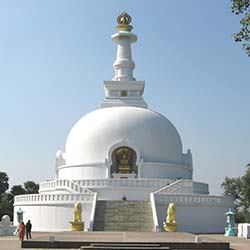
About Vishwa Shanti Stupa, Vaishali Vishwa Shanti Stupa, located in Vaishali, Bihar, is a symbol of peace and harmony. This majestic monument stands tall as a beacon of tranquility in the bustling town. The stupa is a unique blend of history, architecture, and cultural significance, making it a must-visit destination for tourists and pilgrims alike. History, Architecture, and Design Constructed in 1996 by the Nipponzan Myohoji sect of Japan, the Vishwa Shanti Stupa is a stunning example of Buddhist architecture. The stupa's design reflects the principles of peace and non-violence, with intricate carvings and sculptures adorning its walls. The stupa's construction is a testament to the strong cultural ties between India and Japan, symbolizing the enduring friendship between the two nations. Best Time to Visit The best time to visit Vishwa Shanti Stupa is during the winter months, from October to March. The weather is pleasant and ideal for exploring the stupa and its surroundings. Avoid visiting during the monsoon season, as heavy rains may disrupt your trip. Cultural Significance Vishwa Shanti Stupa holds immense cultural significance for Buddhists and people of all faiths. It serves as a place of meditation and reflection, where visitors can experience inner peace and spiritual enlightenment. The stupa's serene ambiance and beautiful surroundings make it a popular pilgrimage site for those seeking solace and tranquility. Pilgrimage Practices Visitors to Vishwa Shanti Stupa are encouraged to participate in meditation sessions and prayer rituals conducted by the resident monks. Pilgrims can also offer prayers and light candles at the stupa, seeking blessings and guidance for their spiritual journey. It is essential to maintain silence and reverence while visiting the stupa, to respect its sacredness. Dress Code and Etiquette While visiting Vishwa Shanti Stupa, it is advisable to dress modestly and respectfully. Both men and women should wear clothing that covers their shoulders and knees, out of respect for the religious significance of the site. Visitors are also expected to remove their shoes before entering the stupa premises, as a sign of reverence and humility. Activities and Experiences At Vishwa Shanti Stupa, visitors can engage in a variety of activities that promote peace and harmony. From attending meditation workshops to participating in cultural events, there are ample opportunities to immerse yourself in the spiritual ambiance of the stupa. Don't miss the chance to witness the evening prayer ceremony, where the stupa is illuminated with glowing lights and chants fill the air. Art and Religious Symbols The Vishwa Shanti Stupa is adorned with intricate artworks and religious symbols that convey deep spiritual meanings. From Buddha's teachings to symbols of peace and enlightenment, the stupa's architecture is a visual representation of Buddhist philosophy. Each carving and sculpture tells a story of compassion, wisdom, and inner harmony, inspiring visitors to seek a higher state of consciousness. Local Insights Exploring Vishwa Shanti Stupa offers a unique opportunity to learn about the local culture and traditions of Vaishali. Interact with the resident monks and locals to gain insights into the history and significance of the stupa. Visit nearby temples and markets to experience the vibrant essence of Vaishali, and savor traditional dishes at local eateries for a taste of authentic Bihar cuisine.
Explore More6 Days Varanasi - Bodhgaya - Prayagraj Tour
6 Days/ 5 Night
Prayagraj - Varanasi - Bodhgaya - Sarnath
4 Night - 5 Day Tour Of Bihar
5 Days/ 4 Night
Bodhgaya - Gaya - Nalanda - Rajgir
Banaras - Ayodhya - Prayagraj Trip For 8 Days
8 Days/ 7 Night
Prayagraj - Varanasi - Bodhgaya - Gaya - Ayodhya - Chitrakoot
6 Days Varanasi - Bodhgaya - Rajgir - Nalanda - Patna Tour
6 Days/ 5 Night
Prayagraj - Varanasi - Bodhgaya - Patna - Rajgir - Sarnath